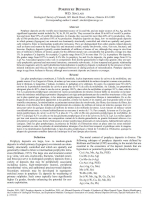Добрый день, Коллеги. Важное сообщение, просьба принять участие. Музей Ферсмана ищет помощь для реставрационных работ в помещении. Подробности по ссылке
Exploration for epithermal gold deposits / Изучение эпитермальных месторождений золота
The successful exploration geologist uses knowledge of geologic relationships and ore-deposit styles, tempered by experience, to interpret all information available from a given prospect in order to develop an understanding of its mineral potential. In the case of exploration for epithermal gold deposits, this understanding can be augmented by familiarity with active hydrothermal systems, their present-day analogues. Just as geological skills and exploration experience are the defining elements of a philosophy of exploration, the needs of a company determine, as much as the funding and skills available, which level of exploration it pursues and where: grassroots, early-stage or advanced targets. Epithermal gold deposits have size, geometry, and grade variations that can be broadly organized around some genetic classes and, therefore, influence the exploration approach or philosophy.
Nearly 80 years ago, Waldemar Lindgren defined the epithermal environment as being shallow in depth, typically hosting deposits of Au, Ag, and base metals plus Hg, Sb, S, kaolinite, alunite, and silica. Even before this, Ransome recognized two distinct styles of such precious-metal deposits, leading to the conclusion that the two end-member deposits form in environments analogous to geothermal springs and volcanic fumaroles, which are dominated by reduced, neutral-pH versus oxidized, acidic fluids, respectively. The terms we use are low- and high-sulfidation to refer to deposits formed in these respective environments. The terms are based on the sulfidation state of the sulfide assemblage. End-member lowsulfidation deposits contain pyrite-pyrrhotite-arsenopyrite and high Fe sphalerite, in contrast to pyriteenargite-luzonite-covellite typifying highsulfidation deposits. A subset of the low-sulfidation style has an intermediate sullidation-state assemblage of pyrite-tetrahedrite/tennantite-chalcopyrite and low Fe sphalerite. Intermediate sulfidation-state deposits are Ag and base metal-rich compared to the Au-rich end-member low-sulfidation deposits, most likely reflecting salinity variations. <...>




